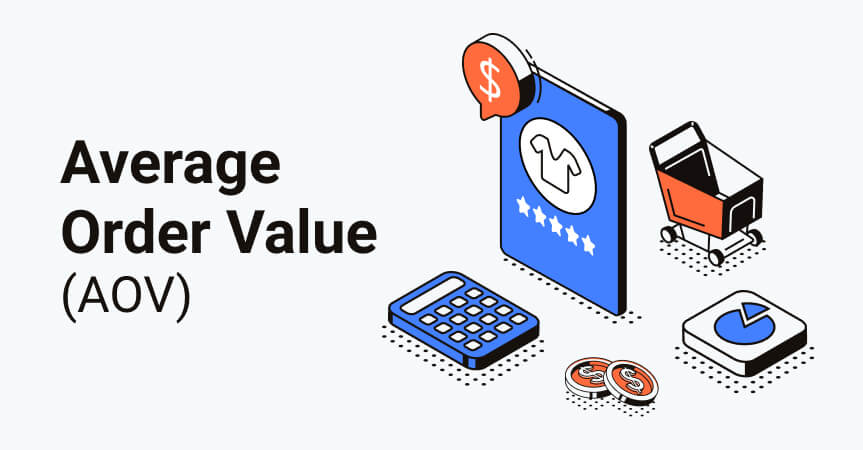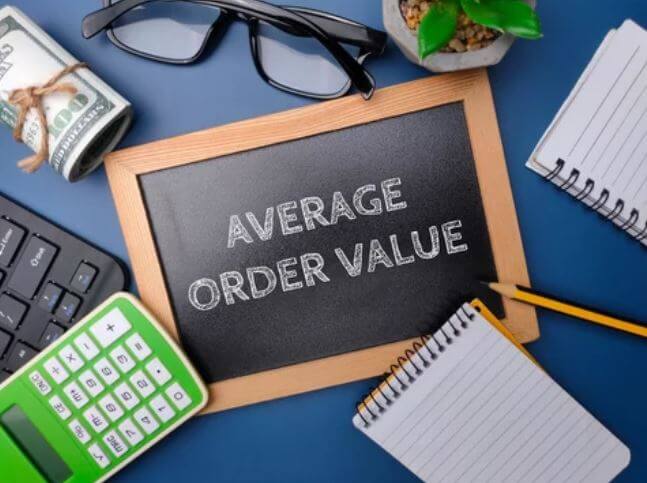Average Order Value (AOV)
Introduction to Average Order Value (AOV)
In the world of e-commerce, it’s essential to understand how to measure the success of your business. One of the most important metrics to track is the Average Order Value (AOV). AOV is a key performance indicator (KPI) representing the average a customer spends by customer per Order. In other words, it shows the average value of each transaction made on your website.
Definition metrics
A metrics that can provide valuable insights into your business performance. It’s calculated by dividing the total revenue generated by the number of orders received during a specific period. For instance, if a company generates $10,000 in monthly revenue charges, the AOV is $100.
Importance of AOV in E-commerce
The AOV is an essential metric for e-commerce businesses because it helps you with customer behavior and buying patterns. Tracking your AOV can help grow opportunities and determine your marketing strategies’ effectiveness strategies. By analyzing the AOV, you can better understand your customer’s purchasing behavior and where you can improve your sales.
Factors that affect AOV
Several factors can impact your AOV, including:
- Product pricing: The price of your products can affect the AOV. Offering discounts or bundling products can increase the average Order.
- Cross-selling and upselling: Suggesting related products or upgrades can encourage customers to purchase more items in a single transaction, increasing the AOV.
- Promotions and discounts: Offering promotions or discounts on bulk purchases can increase the value of each transaction.
- Product recommendations: Recommending similar products or items frequently purchased together can increase the likelihood of customers buying more.
- Shopping experience: Providing a seamless and enjoyable shopping experience can encourage customers to make larger purchases, increasing the AOV.
Understanding and tracking your Average Order Value (AOV) is crucial for e-commerce businesses looking to improve their sales and customer experience. By analyzing your AOV, you can identify areas for growth, optimize your pricing and promotional strategies, and improve your customers’ shopping experience.
Calculating Average Order Value (AOV)
The Average Order (AOV) is a crucial metric for e-commerce businesses to track. It represents the average value of each transaction made n your site and can provide valuable insights into your business performance. Calculating the AOV is relatively straightforward and can be done using a formula.
The formula for calculating AOV
To calculatmustOV, you need to divide the total revenue generated by the number of orders received during a specific period. The formula for calculating AOV is as follows:
AOV = Total Revenue / Number of Orders
For example, suppose a company generated $10,000 in revenue from 100 orders in a month. In that case, the AOV is calculated as follows:
AOV = $10,000 / 100 = $100
Example of calculating AOV
Suppose an e-commerce business generated $50,000 in revenue monthly orders. In that case, the AOV is calculated as follows:
AOV = $50,000 / 500 = $100
This means that the average value of each transaction on the website is $100.
It’s important to note that the AOV can fluctuate depending on the period you’re measuring. For example, the AOV during the holiday season might be higher than the year’s duties due to increased purchasing activity.
Calculating the Average Order is a simple yet essential task for e-commerce businesses. By tracking this metric, you can gain valuable insights into your business performance, identify areas for improvement, and optimize your pricing and promotional strategies.
Strategies to Increase Average Order Value (AOV)
The Average Order Value (AOV) is a crucial metric for e-commerce businesses to track. It represents the average value of each transaction made on your website, and increasing it can significantly impact your revenue and profitability. Here are some practical improvements for increasing your AOV:
Cross-Selling and Upselling Techniques
Cross-selling and upselling are effective techniques for increasing the AOV by suggesting related products or upgradesYouiced items; you can encourage customers to make l by recommending complementary products or higher-priced items larger purchases. Some effective cross-selling and upselling techniques include:
- Suggesting related prod associated with offering related products to customers can increase the value of each transaction. For example, if the purchaser purchases a camera, suggesting camera lenses or memory cards can increase the AOV.
- Offering upgrades: Encouraging customers to purchase their purchases can increase the value of each transaction. For example, offering a premium version of a product can lead to a higher AOV.
Offering Discounts and Promotions
Offering discounts and promotions can increase the AOV by encouraging customers to purchase more. Here are some strategies for providing deals and promotions:
- Offering bulk discounts: Offering discounts on bulk purchases can increase the value of each transaction. For exact countering, a deal when customers purchase multiple items can lead to a higher AOV.
- Offering free shipping: Offering free shipping for orders over a certain amount can encourage customers to make larger purchases.
Improving Product Recommendations
Improving product recommendations can increase the likelihood of customers purchasing more items, increasing the AOV. Here are some strategies for improving product recommendations:
- Personalization: Personalizing product recommendations based on a customer’s browsing and purchase history and their likelihood of purchasing.
- Frequently purchased together: Recommending proc-commonly commonly purchased together can increase the value of each transaction.
Improving the Shopping Experience
Improving the shopping experience can encourage customers to make larger purchases, increasing the AOV. Here are some strategies for improving the shopping experience:
- Simplifying the cheItheckout process can reduce cart abandonment rates and increase customers’ likelihood of purchasing.
- Providing producDetailedviding detailed product information and high-quality images can increase the likelihood of purchasing king a purchase.
Using Data Analysis to Improve AOV
Data analysis can provide valuable insights into customer behavior and help you identify opportunities to increase the AOV. Here are some strategies for using data analysis:
- Analyzing customer behavior: Analyzing customer behavior can provide insights into their purchasing patterns, allowing you to identify opportunities to increase the AOV. Conducting: A/B testing can help you identify the most effective pricing and promotional strategies for improving the AOV.
- Increasing the Average Order is crucial for e-commerce businesses looking to maximize their revenue and profitability. By using effective cross-selling and upselling techniques, offering discounts and promotions, improving product recommendations, enhancing the shopping experience, and using data analysis, you can increase the AOV and take your business to the next level.
Best Practices for Monitoring and Improving AOV
The Average Order Value (AOV) is a crucial metric for e-commerce businesses to track. It represents the average value of each transaction made on your website, and monitoring and improving it can significantly impact your revenue and profitability. Here are some best practices for monitoring and improving your AOV:
Analyzing Sales Data
Analyzing sales data can provide valuable insights into your AOV and help you identify opportunities for improvement. Here are some strategies for analyzing sales data:
- Segmenting data: Segmenting your sales data can help you identify patterns and trends in your AOV. For example, you can segment your data by product category or customer demographic.
- Analyzing metrics: Analyzing metrics such as conversion rates, traffic sources, and bounce rates can provide insights into customer behavior and help you identify areas for improvement.
Conducting A/B Testing
Conducting A/B testing can help you identify the most effective pricing and promotional strategies for increasing your AOV. Here are some methods for conducting A/B testing:
- Testing pricing strategies: Different pricing strategies, such as offering discounts or bundling products, can help you identify the most effective pricing strategy for increasing your AOV.
- Testing promotional strategies: Testing different promotional strategies, such as offering free shipping or running a limited-time sale, can help you identify the most effective promotional strategy for increasing your AOV.
Identifying Customer Trends and Behaviors
Identifying customer trends and behaviors can help optimize pricing and promotional strategies to increase your AOV. Here are some methods for identifying customer trends and behaviors:
- Analyzing customer feedback: Analyzing customer feedback can provide valuable insights into their purchasing behavior and help you identify areas for improvement.
- Tracking customer behavior: Tracking customer behavior, such as their browsing and purchase history, can help you identify patterns and trends in their purchasing behavior.
Collaborating with Marketing and Sales Teams
Collaborating with your marketing and sales teams can help you develop effective strategies for increasing your AOV. Here are some strategies for collaborating with your marketing and sales teams:
- Sharing data and insights: Sharing sales data and insights with your marketing and sales teams can help them develop effective strategies for increasing your AOV.
- Working together on promotions: Collaborating on promotional strategies, such as offering discounts or running a sale, can help you increase your AOV.
Monitoring and improving your Average Order Value (AOV) is a crucial goal for e-commerce businesses looking to maximize their revenue and profitability. By analyzing sales data, conducting A/B testing, identifying customer trends and behaviors, and collaborating with your marketing and sales teams, you can identify opportunities for improvement and develop effective strategies for increasing your AOV.
Conclusion and Future Outlook for AOV
The Average Order Value (AOV) is a crucial metric for e-commerce businesses to track. It represents the average value of each transaction made on your website, and increasing it can significantly impact your revenue and profitability. In this article, we have discussed the definition of AOV, its importance in e-commerce, and strategies for increasing and monitoring it. In this final section, we will summarize the key points and discuss the future outlook for AOV.
Summary of AOV Importance and Strategies
The AOV is a critical metric for e-commerce businesses looking to maximize their revenue and profitability. By understanding and monitoring your AOV, you can gain valuable insights into your customer behavior, identify areas for improvement, and develop effective strategies for increasing your AOV. Some of the most effective strategies for increasing your AOV include cross-selling and upselling, offering discounts and promotions, improving product recommendations, enhancing the shopping experience, and using data analysis.
Future Trends in AOV and E-commerce
The future outlook for AOV and e-commerce is promising, with new technologies and strategies emerging that can help businesses increase their AOV. Here are some future trends to watch for:
- Personalization: Personalizing product recommendations and marketing messages based on individual customer behavior can help businesses increase their AOV by providing a more personalized shopping experience.
- Artificial Intelligence (AI): AI-powered technologies like chatbots and recommendation engines can help businesses improve product recommendations and provide a more personalized shopping experience.
- Augmented Reality (AR): AR technologies can help businesses enhance the shopping experience by allowing customers to visualize products in their homes before purchasing.
- Subscription models: Subscription models can help businesses increase their AOV by providing recurring revenue and encouraging customers to make larger purchases.
The Average Order Value (AOV) is a crucial metric for e-commerce businesses to track. By understanding and monitoring your AOV, you can gain valuable insights into your customer behavior, identify areas for improvement, and develop effective strategies for increasing your AOV. The future outlook for AOV and e-commerce is promising, with new technologies and techniques emerging that can help businesses improve their AOV and stay competitive in a rapidly changing marketplace.
F.A.Q
What is the average order value in KPI?
The Average Order Value (AOV) is a key performance indicator (KPI) used in e-commerce businesses to measure the average value of each transaction made on a website. It is calculated by dividing the total revenue generated by the number of orders received during a specific period. AOV is a valuable metric that provides insights into customer behavior, helps identify areas for improvement, and informs pricing and promotional strategies.
What is the average order value in Shopify?
In Shopify, the Average Order Value (AOV) is a metric representing the average value of each transaction made on the website. It is calculated by dividing the total revenue generated by the number of orders received during a specific period. Shopify provides an AOV report that can be accessed in the analytics section of the dashboard. This report provides insights into customer behavior and helps identify areas for improvement. Shopify offers features and apps that can help increase the AOV, such as cross-selling and upselling tools, promotions and discounts, and product recommendation algorithms.






